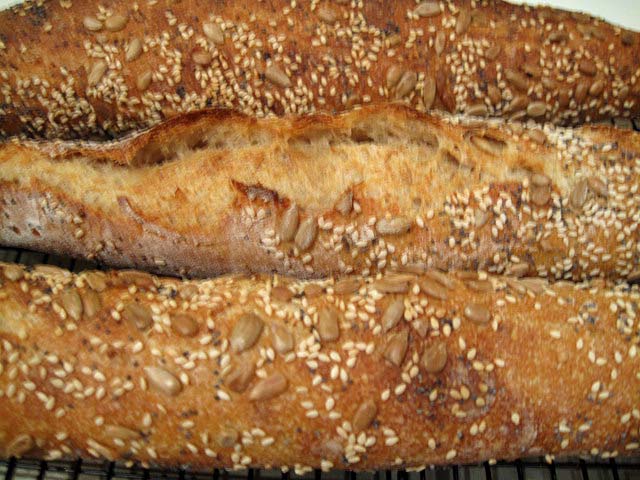
This weekend's baking: Tartine Basic Country Bread and Seeded baguettes

Basic Country Bread from Tartine Bread

Basic Country Bread from Tartine Bread crumb
I made this following the recipe in the book. The whole wheat flour was freshly milled. The bread was delicious.
I always end up with a couple hundred grams of extra levain when I make the Basic Country Bread. I hate throwing it away, so, this week, I made a batch of baguettes with it. The 70% hydration dough was hand mixed and fermented for 2 hours with stretch and folds in the bowl every 30 minutes, then fermented for another 90 minutes with stretch and folds on the board at 45 and 90 minutes. I retarded the dough in bulk overnight. This afternoon, I divided the dough, pre-shaped it and let it rest for an hour. Then, the baguettes were shaped, rolled on wet paper towels then in mixed seeds and proofed en couche for 45 minutes before baking at 450ºF for 20 minutes.

Seeded baguettes

Seeded baguette crumb
The flavor was very much like the Tartine Basic Country Bread except more sour. Very nice.
David


Comments
Very nice looking baguettes David. I don't think I have ever seeded baguettes but the combination seems perfect for the high crust ratio of this bread form. Do you toast the sunflower seeds prior to using them or do they get enough toasting during baking?
Eric
Seeded baguettes are a favorite of my wife's. They are very nice plain and also with cheese. The seeds are not toasted before coating the baguettes.
David
Love the look of those seeded baguettes David
Very tasty!
Best wishes
Andy
David
Great Looking Breads, David.. I will try to imitate your seed on baguette someday..
David - When I first discovered TFL more than a year ago it was mostly your posts, and photos of your results that inspired me to take up bread baking using levain.
I notice that these boules have no visible flour coating. Do you brush it off after the loaves cool, or do you use some other method to keep the raw dough from sticking to the basket when you unmold before baking?
Thanks for all the inspiration!
Thanks for the kind words.
These boules were proofed in linen-lined bannetons. The liners were lightly dusted with a 50/50 mix of AP and Rice Flour using a dredging can with a perforated top. You can do the same shaking the flour mix through a fine-mesh strainer. The linen is somewhat non-stick naturally, so only a light dusting is necessary. I seldom get any sticking at all. The loaves usually drop right onto the peel, even when the dough is pretty slack.
David
Hello David, The seed topping for your baguettes is a nice finishing touch.
Lovely breads as always.
from breadsong
David
Wow what beautiful bread, David!
I just watched a video of Robertson: vimeo.com: Tartine bread video (this is a link)
His boule shaping technique is very cool.
-Elizabeth
Nice to see you. It seems like it's been a while.
David
Thank you David; it HAS been a while.It's nice to be back.
I can't get over how beautiful the crumb is in the seeded baguette. It's always so thrilling when the bubbles are shiny like that.
-Elizabeth
great results, David! I baked the seeded baguette you posted last year, and loved it.
Why did you roll the shaped baguettes in wet paper towels? To make the seeds stick? Is that easier than misting them with water?
Greetings from a trip to Hamburg (with infrequent internet access),
Karin
The loaves are rolled in wet paper towels to help the seeds stick. This is the technique we were taught at SFBI. Spraying the loaves seems to result in more uneven wetting. Too much water in spots on the surface of the loaf can result in blotchy crust coloration with baking.
David
This sounds like a great idea. Are the paper towels soaking wet or just damp? (I'm thinking about using a tea towel rather than paper towels and wonder just how wet it should be)
-Elizabeth
Hi,
I am hoping you have an answer for me.....I have used the Tartine formula once, so far, and can't figure out why he has us build way more leaven than will be needed for the formula he has outlined in the book....
When baking with sourdough I always just build the amount of leaven that I will need plus a bit extra for 'next time'. He instructs to build double the amount required....(I think..)
Is there a specific reason for that? Only thing I can come up with is that the yeast react differently given so much 'space' to grow in....less 'toxic' waste to flounder in....and that somehow changes how the leaven behaves once added to the final ingredients...
But basically - I am clueless here.... ;-)
Thanks for any help you might have to offer!